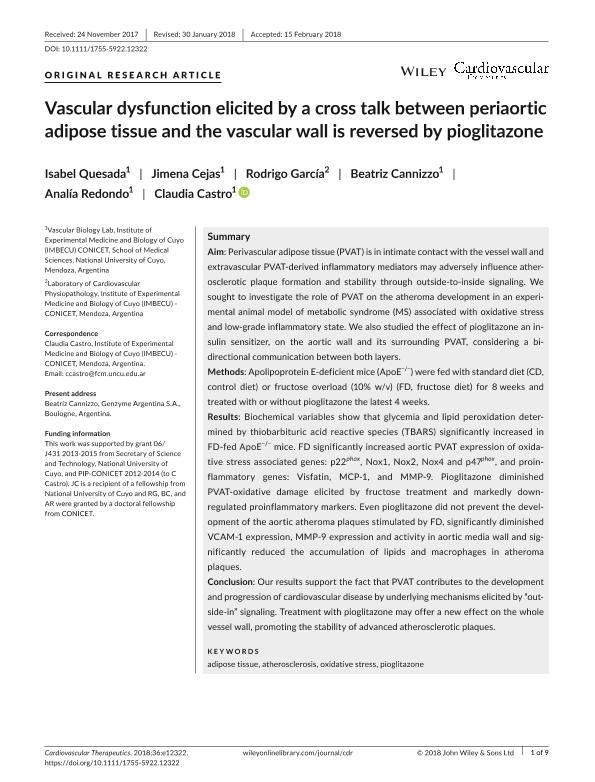Artículo
Vascular dysfunction elicited by a cross talk between periaortic adipose tissue and the vascular wall is reversed by pioglitazone
Quesada, Isabel María ; Cejas, Jimena Beatriz; Garcia, Rodrigo; Cannizzo, Beatriz
; Cejas, Jimena Beatriz; Garcia, Rodrigo; Cannizzo, Beatriz ; Redondo, Analia Lourdes
; Redondo, Analia Lourdes ; Castro, Claudia Magdalena
; Castro, Claudia Magdalena
 ; Cejas, Jimena Beatriz; Garcia, Rodrigo; Cannizzo, Beatriz
; Cejas, Jimena Beatriz; Garcia, Rodrigo; Cannizzo, Beatriz ; Redondo, Analia Lourdes
; Redondo, Analia Lourdes ; Castro, Claudia Magdalena
; Castro, Claudia Magdalena
Fecha de publicación:
06/2018
Editorial:
Wiley Blackwell Publishing, Inc
Revista:
Cardiovascular Therapeutics
ISSN:
1755-5914
Idioma:
Inglés
Tipo de recurso:
Artículo publicado
Clasificación temática:
Resumen
Aim: Perivascular adipose tissue (PVAT) is in intimate contact with the vessel wall and extravascular PVAT-derived inflammatory mediators may adversely influence atherosclerotic plaque formation and stability through outside-to-inside signaling. We sought to investigate the role of PVAT on the atheroma development in an experimental animal model of metabolic syndrome (MS) associated with oxidative stress and low-grade inflammatory state. We also studied the effect of pioglitazone an insulin sensitizer, on the aortic wall and its surrounding PVAT, considering a bi-directional communication between both layers. Methods: Apolipoprotein E-deficient mice (ApoE−/−) were fed with standard diet (CD, control diet) or fructose overload (10% w/v) (FD, fructose diet) for 8 weeks and treated with or without pioglitazone the latest 4 weeks. Results: Biochemical variables show that glycemia and lipid peroxidation determined by thiobarbituric acid reactive species (TBARS) significantly increased in FD-fed ApoE−/− mice. FD significantly increased aortic PVAT expression of oxidative stress associated genes: p22phox, Nox1, Nox2, Nox4 and p47phox, and proinflammatory genes: Visfatin, MCP-1, and MMP-9. Pioglitazone diminished PVAT-oxidative damage elicited by fructose treatment and markedly down-regulated proinflammatory markers. Even pioglitazone did not prevent the development of the aortic atheroma plaques stimulated by FD, significantly diminished VCAM-1 expression, MMP-9 expression and activity in aortic media wall and significantly reduced the accumulation of lipids and macrophages in atheroma plaques. Conclusion: Our results support the fact that PVAT contributes to the development and progression of cardiovascular disease by underlying mechanisms elicited by “outside-in” signaling. Treatment with pioglitazone may offer a new effect on the whole vessel wall, promoting the stability of advanced atherosclerotic plaques.
Palabras clave:
ADIPOSE TISSUE
,
ATHEROSCLEROSIS
,
OXIDATIVE STRESS
,
PIOGLITAZONE
Archivos asociados
Licencia
Identificadores
Colecciones
Articulos(IMBECU)
Articulos de INST. DE MEDICINA Y BIO. EXP. DE CUYO
Articulos de INST. DE MEDICINA Y BIO. EXP. DE CUYO
Citación
Quesada, Isabel María; Cejas, Jimena Beatriz; Garcia, Rodrigo; Cannizzo, Beatriz; Redondo, Analia Lourdes; et al.; Vascular dysfunction elicited by a cross talk between periaortic adipose tissue and the vascular wall is reversed by pioglitazone; Wiley Blackwell Publishing, Inc; Cardiovascular Therapeutics; 36; 3; 6-2018; 1-9
Compartir
Altmétricas



